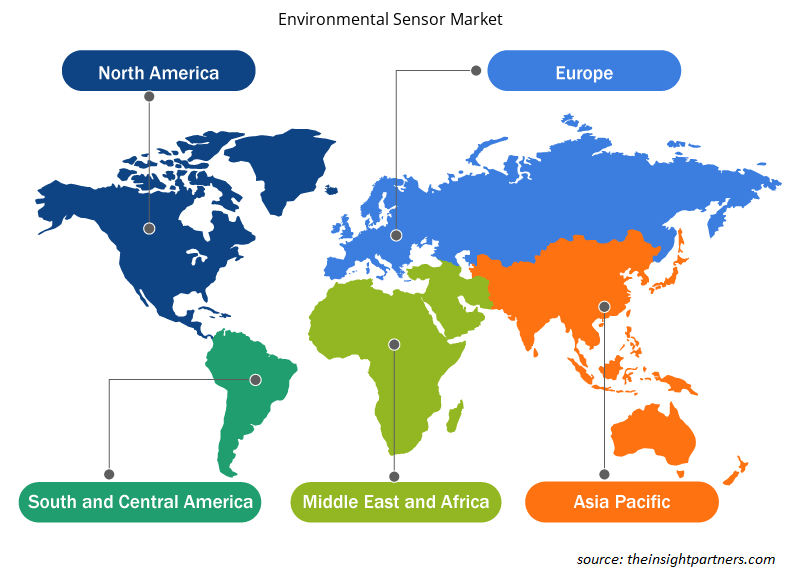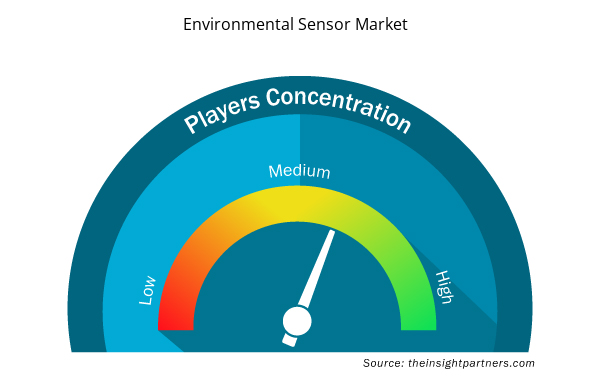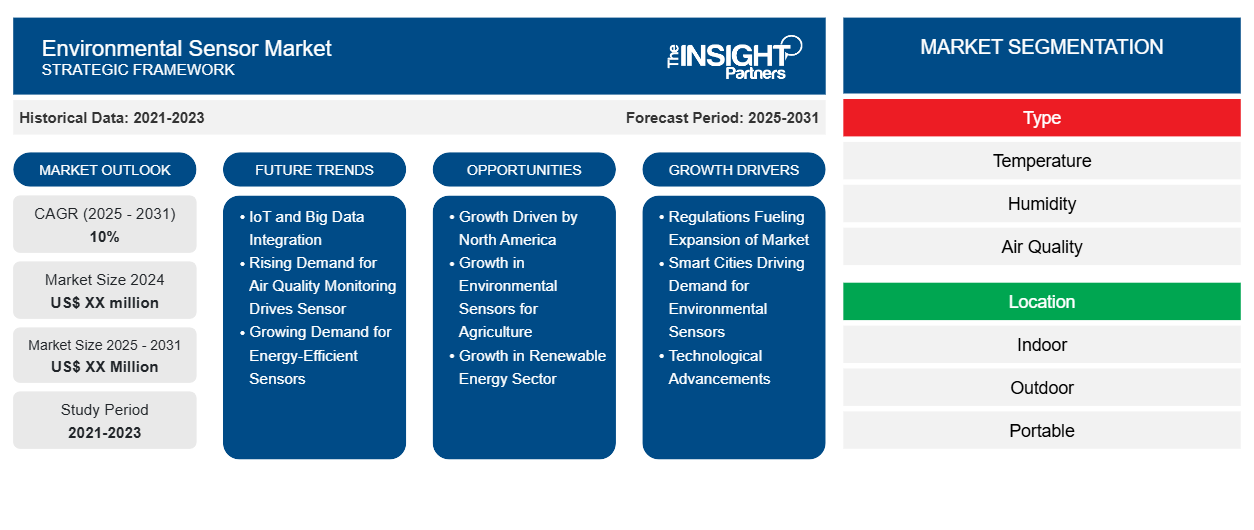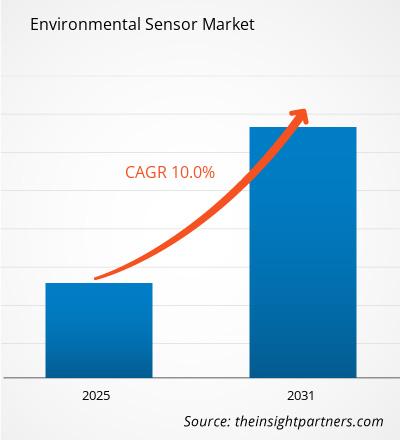Es wird erwartet, dass der Markt für Umweltsensoren von 2023 bis 2031 eine durchschnittliche jährliche Wachstumsrate (CAGR) von 10 % verzeichnet, wobei die Marktgröße von XX Millionen US-Dollar im Jahr 2023 auf XX Millionen US-Dollar bis 2031 wächst.
Der Marktbericht für Umweltsensoren umfasst Analysen nach Typ, Standort und Branche. Die globale Analyse wird weiter auf regionaler Ebene und in die wichtigsten Länder unterteilt. Der Bericht bietet den Wert in USD für die oben genannten Analysen und Segmente.
Zweck des Berichts
Der Bericht „Umweltsensormarkt“ von The Insight Partners zielt darauf ab, die aktuelle Situation und das zukünftige Wachstum sowie die wichtigsten treibenden Faktoren, Herausforderungen und Chancen zu beschreiben. Dies wird verschiedenen Geschäftspartnern Einblicke geben, wie zum Beispiel:
- Technologieanbieter/-hersteller: Um die sich entwickelnde Marktdynamik zu verstehen und die potenziellen Wachstumschancen zu kennen, damit sie fundierte strategische Entscheidungen treffen können.
- Investoren: Durchführung einer umfassenden Trendanalyse hinsichtlich der Marktwachstumsrate, der finanziellen Marktprognosen und der Chancen entlang der Wertschöpfungskette.
- Regulierungsbehörden: Zur Regulierung von Richtlinien und Überwachungsaktivitäten auf dem Markt mit dem Ziel, Missbrauch zu minimieren, das Vertrauen der Anleger zu bewahren und die Integrität und Stabilität des Marktes aufrechtzuerhalten.
Umweltsensor-Marktsegmentierung
Typ
- Temperatur
- Luftfeuchtigkeit
- Luftqualität
- UV
- Bodenfeuchtigkeit
- Wasserqualität
Standort
- Innenbereich
- Im Freien
- Tragbar
Vertikal
- Regierung und öffentliche Versorgungsunternehmen
- Kommerziell
- Unternehmen
- Unterhaltungselektronik
- Wohnen
- Gesundheitswesen und Pharma
- Industrie
Geographie
- Nordamerika
- Europa
- Asien-Pazifik
- Süd- und Mittelamerika
- Naher Osten und Afrika
Geographie
- Nordamerika
- Europa
- Asien-Pazifik
- Süd- und Mittelamerika
- Naher Osten und Afrika
Passen Sie diesen Bericht Ihren Anforderungen an
Sie erhalten kostenlos individuelle Anpassungen an jedem Bericht, einschließlich Teilen dieses Berichts oder einer Analyse auf Länderebene, eines Excel-Datenpakets sowie tolle Angebote und Rabatte für Start-ups und Universitäten.
- Holen Sie sich die wichtigsten Markttrends aus diesem Bericht.Dieses KOSTENLOSE Beispiel umfasst eine Datenanalyse von Markttrends bis hin zu Schätzungen und Prognosen.
Wachstumstreiber auf dem Markt für Umweltsensoren
- Regulierungen treiben die Expansion des Marktes voran: Das Wachstum des Marktes für Umweltsensoren wird hauptsächlich durch die steigende Nachfrage der Öffentlichkeit und der Regulierungsbehörden nach der Überwachung der Umweltverschmutzung und der Durchsetzung des Umweltschutzes verursacht. Auf der ganzen Welt setzen Regierungen und Regulierungsbehörden strengere Standards für Luft- und Wasserqualität durch, die den Einsatz von Umweltsensoren erfordern. Die einzuhaltenden Vorschriften erfordern den Einsatz von Umweltsensoren und vergrößern somit die Größe des Marktes für Umweltsensoren, da die Industrie solche Maßnahmen ergreift. Laut PEST ist die regulatorische Unterstützung einer der Gründe für das Wachstum eines globalen Marktes für Umweltwerkzeuge in Form von Sensoren.
- Smart Cities treiben die Nachfrage nach Umweltsensoren an: Schnell wachsende Smart Cities auf der ganzen Welt sind ein Segen für den Markt für Umweltsensoren, da Umweltsensoren im Mittelpunkt der Überwachung der städtischen Umweltverschmutzung stehen und gleichzeitig die Ressourcen im städtischen Raum optimieren. Mit der Implementierung von IoT-basierten Umweltüberwachungslösungen verzeichneten mehrere Städte eine steigende Nachfrage nach solchen Sensoren. Eine sorgfältige Wettbewerbsanalyse zeigt, dass jeder der Hauptakteure darauf aus zu sein scheint, Allianzen für Smart City-Projekte zu bilden und die Einführung von Technologien zu beschleunigen, um eine weitverbreitete Nutzung von Umweltsensoren in allen Arten von städtischen Szenarien auf der ganzen Welt sicherzustellen.
- Technologische Fortschritte: Technologische Innovationen bei der Miniaturisierung und Präzision von Sensoren verbessern die Umweltsensoren, was das Marktwachstum weiter fördert. Die bessere Empfindlichkeit und Zuverlässigkeit von Sensoren machen sie für verschiedene Anwendungen wie industrielle Überwachung und tragbare Verbrauchergeräte geeignet. Marktstudien zeigen, dass das Wachstum der Sensortechnologie erheblich zum Wachstum des Marktes für Umweltsensoren beiträgt und Hersteller durch dieses Wachstum neue Märkte erschließen können. Dieses Phänomen fördert das Wachstum des globalen Marktes für Umweltsensoren weiter, da Unternehmen beginnen, hochpräzise Sensoren einzusetzen und so eine innovative und wettbewerbsfähige Landschaft schaffen.
Zukünftige Trends auf dem Markt für Umweltsensoren
- IoT- und Big-Data-Integration: Der Markt für Umweltsensoren ist auf dem Vormarsch und integriert IoT- und Big-Data-Analysen in Echtzeit, um die Umwelt zu verfolgen und daraus prädiktive Erkenntnisse abzuleiten. Laut der SWOT-Analyse bietet diese Integration Branchen Vorteile durch effiziente Datenerfassung und Zugang zu verbesserter Entscheidungsfindung. Die Dynamik des Marktes für Umweltsensoren zeigt, dass große Unternehmen die Strategie verfolgen, den Sensormarkt zu erobern, indem sie in marktorientierte IoT-fähige Sensoren investieren und sich dabei auf Sektoren wie Landwirtschaft und Fertigungsanwendungen konzentrieren. Diese Tatsache treibt auch das Marktwachstum in weiteren Prognosen an, da die Entwicklung und Nutzung des IoT immer weiter zunimmt und den Anwendungsbereich von Sensoren in diesen Branchen erweitert.
- Steigende Nachfrage nach Luftqualitätsüberwachung treibt Sensoren voran: Mit zunehmender städtischer Verschmutzung wächst die Nachfrage nach Luftqualitätsüberwachung weiter, was die Notwendigkeit schafft, Schadstoffe und Partikel zu überwachen. Die Marktanalyse für Umweltsensoren zeigt, wie Verbraucher, Kommunen und Industrien in Luftqualitätsüberwachungstechnologie investieren. Große Akteure stellen Sensoren speziell für diesen Anwendungsbereich her und nutzen Marktstrategien für städtische und industrielle Anforderungen. Die zukünftigen Marktaussichten stellen sicher, dass die Luftqualitätsüberwachung in den kommenden Jahren ein kritisches Brennpunkt für Sensoren sein wird.
- Wachsende Nachfrage nach energieeffizienten Sensoren: Der Markt für energieeffiziente Umweltsensoren wächst, da Industrie und Regierung zunehmend Wert auf die Nachhaltigkeit eines bestimmten Produkts legen. Energieeffiziente Sensoren erhöhen die Lebensdauer im Betrieb und minimieren den Stromverbrauch, was die ökologischen Ziele der meisten Branchen unterstützt. Die SWOT-Analyse zeigt, dass die Marktkräfte immer auf der Seite der stromsparenden Sensoren stehen, da die führenden Akteure energieeffiziente Technologien einsetzen. Dieser Trend bestätigt die Marktprognose, wonach energieeffiziente Designs Branchen anziehen, die sich auf die Reduzierung der ökologischen Auswirkungen konzentrieren.
Marktchancen für Umweltsensoren
- Wachstumstreiber Nordamerika: Nordamerika bietet erhebliche Wachstumschancen auf dem Markt für Umweltsensoren, insbesondere für Industriezweige, in denen strenge Vorschriften zur Schadstoff- und Emissionskontrolle gelten. Die Marktanalyse zeigt eine hohe Akzeptanzrate, da sich die Industrien stärker auf die Aspekte Compliance und Nachhaltigkeit konzentrieren. Diese Region gilt hinsichtlich des Marktanteils als positives Wachstumsgebiet, und die Hersteller investieren weiterhin in fortschrittliche Sensortechnologie. Nordamerika verfügt über eine sehr starke industrielle Basis und bietet eine der höchsten Wachstumschancen in verschiedenen Anwendungen, in denen Sensoren eingesetzt werden.
- Wachstum bei Umweltsensoren für die Landwirtschaft: Der asiatisch-pazifische Raum bietet Wachstumspotenzial bei Umweltsensoren, insbesondere für landwirtschaftliche Anwendungsfälle, bei denen eine effektive Ressourcenzuweisung von entscheidender Bedeutung ist. Die Marktanteile wachsen, da sich Länder für sensorbasierte Angebote zur Wasser-, Boden- und Klimaüberwachung interessieren. Die Marktlandschaftsanalyse zeigt außerdem, dass die landwirtschaftlichen Praktiken dieser Region Sensoren in der Präzisionslandwirtschaft nutzen, die aufgrund des steigenden Nahrungsmittelbedarfs auf dem Vormarsch ist. Dies ist eine ermutigende Wachstumschance und positioniert den asiatisch-pazifischen Raum als Schlüsselbereich für Anwendungen mit Umweltsensoren in der Landwirtschaft.
- Wachstum im Sektor der erneuerbaren Energien: Der Sektor der erneuerbaren Energien bietet große Wachstumschancen für Umweltsensoren, insbesondere in den Bereichen Emissionsüberwachung, Luftqualität und Ressourcenmanagement. Da die Investitionen in Wind-, Solar- und Wasserkraftprojekte zur Optimierung des Betriebs zunehmen, besteht ein immer größerer Bedarf an Umweltüberwachung. Der Überblick über den Markt für Umweltsensoren zeigt, dass dieser Sektor eine expandierende Region ist, insbesondere in Europa und Nordamerika. Die Akteure der Branche können diese Wachstumschance nutzen, um maßgeschneiderte Sensorlösungen für nachhaltige Energieprogramme anzubieten und so den Marktanteil von Umweltsensoren weiter zu stärken.
Regionale Einblicke in den Markt für Umweltsensoren
Die regionalen Trends und Faktoren, die den Markt für Umweltsensoren im Prognosezeitraum beeinflussen, wurden von den Analysten von Insight Partners ausführlich erläutert. In diesem Abschnitt werden auch Marktsegmente und Geografien für Umweltsensoren in Nordamerika, Europa, im asiatisch-pazifischen Raum, im Nahen Osten und Afrika sowie in Süd- und Mittelamerika erörtert.

- Erhalten Sie regionalspezifische Daten zum Markt für Umweltsensoren
Umfang des Marktberichts zu Umweltsensoren
| Berichtsattribut | Details |
|---|---|
| Marktgröße im Jahr 2023 | XX Millionen US-Dollar |
| Marktgröße bis 2031 | XX Millionen US-Dollar |
| Globale CAGR (2023 - 2031) | 10 % |
| Historische Daten | 2021-2022 |
| Prognosezeitraum | 2024–2031 |
| Abgedeckte Segmente | Nach Typ
|
| Abgedeckte Regionen und Länder | Nordamerika
|
| Marktführer und wichtige Unternehmensprofile |
|
Dichte der Marktteilnehmer für Umweltsensoren: Die Auswirkungen auf die Geschäftsdynamik verstehen
Der Markt für Umweltsensoren wächst rasant, angetrieben durch die steigende Nachfrage der Endnutzer aufgrund von Faktoren wie sich entwickelnden Verbraucherpräferenzen, technologischen Fortschritten und einem größeren Bewusstsein für die Vorteile des Produkts. Mit steigender Nachfrage erweitern Unternehmen ihr Angebot, entwickeln Innovationen, um die Bedürfnisse der Verbraucher zu erfüllen, und nutzen neue Trends, was das Marktwachstum weiter ankurbelt.
Die Marktteilnehmerdichte bezieht sich auf die Verteilung von Firmen oder Unternehmen, die in einem bestimmten Markt oder einer bestimmten Branche tätig sind. Sie gibt an, wie viele Wettbewerber (Marktteilnehmer) in einem bestimmten Marktraum im Verhältnis zu seiner Größe oder seinem gesamten Marktwert präsent sind.
Die wichtigsten auf dem Markt für Umweltsensoren tätigen Unternehmen sind:
- Bosch Sensortec GmbH
- Sensirion
- AMS AG
- Honeywell International Inc
- Siemens AG
Haftungsausschluss : Die oben aufgeführten Unternehmen sind nicht in einer bestimmten Reihenfolge aufgeführt.

- Überblick über die wichtigsten Akteure auf dem Markt für Umweltsensoren
Wichtige Verkaufsargumente
- Umfassende Abdeckung: Der Bericht deckt die Analyse von Produkten, Dienstleistungen, Typen und Endbenutzern des Umweltsensor-Marktes umfassend ab und bietet einen ganzheitlichen Überblick.
- Expertenanalyse: Der Bericht basiert auf dem umfassenden Verständnis von Branchenexperten und Analysten.
- Aktuelle Informationen: Der Bericht stellt durch die Abdeckung aktueller Informationen und Datentrends Geschäftsrelevanz sicher.
- Anpassungsoptionen: Dieser Bericht kann angepasst werden, um spezifische Kundenanforderungen zu erfüllen und die Geschäftsstrategien optimal anzupassen.
Der Forschungsbericht zum Markt für Umweltsensoren kann daher dabei helfen, die Branchensituation und Wachstumsaussichten zu entschlüsseln und zu verstehen. Obwohl es einige berechtigte Bedenken geben kann, überwiegen die allgemeinen Vorteile dieses Berichts tendenziell die Nachteile.
- Historische Analyse (2 Jahre), Basisjahr, Prognose (7 Jahre) mit CAGR
- PEST- und SWOT-Analyse
- Marktgröße Wert/Volumen – Global, Regional, Land
- Branche und Wettbewerbsumfeld
- Excel-Datensatz



Report Coverage
Revenue forecast, Company Analysis, Industry landscape, Growth factors, and Trends

Segment Covered
This text is related
to segments covered.

Regional Scope
North America, Europe, Asia Pacific, Middle East & Africa, South & Central America

Country Scope
This text is related
to country scope.
Häufig gestellte Fragen
The report can be delivered in PDF/PPT format; we can also share excel dataset based on the request.
Some of the customization options available based on request are additional 3-5 company profiles and country-specific analysis of 3-5 countries of your choice. Customizations are to be requested/discussed before making final order confirmation, as our team would review the same and check the feasibility.
Key companies of this market are: Bosch Sensortec GmbH, Sensirion, AMS AG, Honeywell International Inc, Siemens AG, Omron Corporation, Raritan Inc, Texas Instruments Incorporated, Schneider Electric.
Key future trends in this market are - Growth in environmental monitoring, Rise in smart cities, Increased demand for pollution control
The Environmental Sensor Market is expected to register a CAGR of 10% from 2023-2031.
The major factors impacting the Environmental Sensor Market are: Rising Environmental Awareness and Regulatory Standards, Expansion of Smart City Initiatives, and Technological Advancements in Sensor Accuracy and Miniaturization
Trends and growth analysis reports related to Electronics and Semiconductor : READ MORE..
1. Bosch Sensortec GmbH
2. Sensirion
3. AMS AG
4. Honeywell International Inc
5. Siemens AG
6. Omron Corporation
7. Raritan Inc.
8. Texas Instruments Incorporated
9. Schneider Electric
10. STMicroelectronics
The Insight Partners performs research in 4 major stages: Data Collection & Secondary Research, Primary Research, Data Analysis and Data Triangulation & Final Review.
- Data Collection and Secondary Research:
As a market research and consulting firm operating from a decade, we have published and advised several client across the globe. First step for any study will start with an assessment of currently available data and insights from existing reports. Further, historical and current market information is collected from Investor Presentations, Annual Reports, SEC Filings, etc., and other information related to company’s performance and market positioning are gathered from Paid Databases (Factiva, Hoovers, and Reuters) and various other publications available in public domain.
Several associations trade associates, technical forums, institutes, societies and organization are accessed to gain technical as well as market related insights through their publications such as research papers, blogs and press releases related to the studies are referred to get cues about the market. Further, white papers, journals, magazines, and other news articles published in last 3 years are scrutinized and analyzed to understand the current market trends.
- Primary Research:
The primarily interview analysis comprise of data obtained from industry participants interview and answers to survey questions gathered by in-house primary team.
For primary research, interviews are conducted with industry experts/CEOs/Marketing Managers/VPs/Subject Matter Experts from both demand and supply side to get a 360-degree view of the market. The primary team conducts several interviews based on the complexity of the markets to understand the various market trends and dynamics which makes research more credible and precise.
A typical research interview fulfils the following functions:
- Provides first-hand information on the market size, market trends, growth trends, competitive landscape, and outlook
- Validates and strengthens in-house secondary research findings
- Develops the analysis team’s expertise and market understanding
Primary research involves email interactions and telephone interviews for each market, category, segment, and sub-segment across geographies. The participants who typically take part in such a process include, but are not limited to:
- Industry participants: VPs, business development managers, market intelligence managers and national sales managers
- Outside experts: Valuation experts, research analysts and key opinion leaders specializing in the electronics and semiconductor industry.
Below is the breakup of our primary respondents by company, designation, and region:

Once we receive the confirmation from primary research sources or primary respondents, we finalize the base year market estimation and forecast the data as per the macroeconomic and microeconomic factors assessed during data collection.
- Data Analysis:
Once data is validated through both secondary as well as primary respondents, we finalize the market estimations by hypothesis formulation and factor analysis at regional and country level.
- Macro-Economic Factor Analysis:
We analyse macroeconomic indicators such the gross domestic product (GDP), increase in the demand for goods and services across industries, technological advancement, regional economic growth, governmental policies, the influence of COVID-19, PEST analysis, and other aspects. This analysis aids in setting benchmarks for various nations/regions and approximating market splits. Additionally, the general trend of the aforementioned components aid in determining the market's development possibilities.
- Country Level Data:
Various factors that are especially aligned to the country are taken into account to determine the market size for a certain area and country, including the presence of vendors, such as headquarters and offices, the country's GDP, demand patterns, and industry growth. To comprehend the market dynamics for the nation, a number of growth variables, inhibitors, application areas, and current market trends are researched. The aforementioned elements aid in determining the country's overall market's growth potential.
- Company Profile:
The “Table of Contents” is formulated by listing and analyzing more than 25 - 30 companies operating in the market ecosystem across geographies. However, we profile only 10 companies as a standard practice in our syndicate reports. These 10 companies comprise leading, emerging, and regional players. Nonetheless, our analysis is not restricted to the 10 listed companies, we also analyze other companies present in the market to develop a holistic view and understand the prevailing trends. The “Company Profiles” section in the report covers key facts, business description, products & services, financial information, SWOT analysis, and key developments. The financial information presented is extracted from the annual reports and official documents of the publicly listed companies. Upon collecting the information for the sections of respective companies, we verify them via various primary sources and then compile the data in respective company profiles. The company level information helps us in deriving the base number as well as in forecasting the market size.
- Developing Base Number:
Aggregation of sales statistics (2020-2022) and macro-economic factor, and other secondary and primary research insights are utilized to arrive at base number and related market shares for 2022. The data gaps are identified in this step and relevant market data is analyzed, collected from paid primary interviews or databases. On finalizing the base year market size, forecasts are developed on the basis of macro-economic, industry and market growth factors and company level analysis.
- Data Triangulation and Final Review:
The market findings and base year market size calculations are validated from supply as well as demand side. Demand side validations are based on macro-economic factor analysis and benchmarks for respective regions and countries. In case of supply side validations, revenues of major companies are estimated (in case not available) based on industry benchmark, approximate number of employees, product portfolio, and primary interviews revenues are gathered. Further revenue from target product/service segment is assessed to avoid overshooting of market statistics. In case of heavy deviations between supply and demand side values, all thes steps are repeated to achieve synchronization.
We follow an iterative model, wherein we share our research findings with Subject Matter Experts (SME’s) and Key Opinion Leaders (KOLs) until consensus view of the market is not formulated – this model negates any drastic deviation in the opinions of experts. Only validated and universally acceptable research findings are quoted in our reports.
We have important check points that we use to validate our research findings – which we call – data triangulation, where we validate the information, we generate from secondary sources with primary interviews and then we re-validate with our internal data bases and Subject matter experts. This comprehensive model enables us to deliver high quality, reliable data in shortest possible time.


 Holen Sie sich ein kostenloses Muster für diesen Bericht
Holen Sie sich ein kostenloses Muster für diesen Bericht